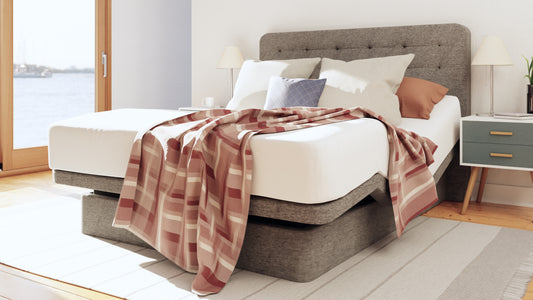Do you or a loved one struggle with sleep apnea? Sleep apnea is a common and frustrating sleep disorder that causes many individuals to relentlessly toss and turn all night trying to get a good night’s sleep. It occurs when the airway is blocked during sleep, causing breathing to stop and start throughout the night. The consequences are all too familiar: snoring, gasping for air, and waking up feeling tired and sluggish the next day. Fortunately, there is hope in managing sleep apnea, including the remarkable benefits of using an adjustable bed.
What is Sleep Apnea?
Sleep apnea, or sleep apnoea as it’s also known, affects a staggering number of people, with an estimated 18 million individuals in the United States alone grappling with this condition. This common sleep disorder is characterized by interruptions in breathing during sleep, which can result in significant health problems if left untreated. Sleep apnea can occur in anyone, regardless of age or gender, but is more prevalent in middle-aged and older adults, particularly those carrying excess weight.
The most common type of sleep apnea is obstructive sleep apnoea (OSA), which is caused by the relaxation of the muscles in the throat during sleep. When these muscles relax, the airway becomes blocked, preventing air from reaching the lungs. Unsurprisingly, OSA can cause snoring, choking, and gasping for air during sleep, leading to poor sleep quality and daytime fatigue. Other factors contributing to sleep apnea include smoking, alcohol consumption, and certain medical conditions such as diabetes and hypertension.
Central sleep apnea is a less common type of sleep apnea that involves a dysfunction in the central nervous system. Unlike OSA, where the airway is physically obstructed, central sleep apnea occurs when the brain fails to transmit the appropriate signals to the muscles responsible for breathing. Consequently, the individual experiences pauses in breathing during sleep. Central sleep apnea is often associated with certain medical conditions, such as heart failure, stroke, or brainstem abnormalities. Symptoms may manifest as difficulty staying asleep, frequent awakenings, and shortness of breath upon waking.
What Are the Symptoms and Health Concerns?
Experiencing symptoms of sleep apnea can be distressing and affects both your sleeping and waking hours. Sleep apnea symptoms can vary depending on the severity of the condition. The most common symptom is loud snoring, which is often followed by periods of silence as breathing stops. Other symptoms may include gasping or choking during sleep, difficulty staying asleep, waking with morning headaches, dry mouth, or sore throat. And then there is the persistent daytime fatigue and sleepiness that can leave you feeling drained and unmotivated.
Beyond the discomfort of these symptoms, sleep apnea can also increase the risk of several health concerns. People with sleep apnea may be at a higher risk of high blood pressure, heart disease, stroke, type 2 diabetes, and liver problems. Additionally, sleep apnea can also worsen existing conditions such as asthma and chronic obstructive pulmonary disease (COPD) and can contribute to issues with depression and anxiety.
If you are experiencing any symptoms of sleep apnea or suspect that you are at risk, it’s important to seek medical attention. Early diagnosis and treatment can make a world of difference in managing and potentially preventing the health consequences of sleep apnea. One of the key strategies for managing sleep apnea is implementing positive lifestyle changes. A common risk factor for sleep apnea is obesity. Losing excess weight through a combination of healthy eating and regular exercise can help alleviate symptoms. And it’s important to limit alcohol consumption before bedtime, as it can exacerbate symptoms. Alcohol can relax the throat muscles and increase longer-lasting breathing interruptions.
Treatment options vary depending on the severity of the condition. A common approach includes using a Continuous Positive Airway Pressure (CPAP) machine as you sleep. CPAP therapy involves wearing a mask over the nose or both nose and mouth throughout the night, delivering a stream of pressurized air that effectively keeps your airway open. By understanding the underlying causes and seeking proper treatments, individuals with sleep apnea can enjoy better sleep and improve their overall health and well-being.

The Benefits of an Adjustable Bed on Sleep Apnea
Many individuals resort to using pillows, body pillows, or wedges to raise their heads to alleviate snoring, but this makeshift solution often falls short. Pillows can slip and shift during the night, disrupting your sleep and potentially causing discomfort or muscle strain. Adjusting and readjusting pillows constantly is tiresome and can be just as disruptive to sleep as the snoring or symptoms you are trying to avoid.
The Dawn House bed system is an excellent option for those who suffer from sleep apnea. A study published on the NIH site reports the adjustable bed feature of head-of-bed-elevation can help alleviate symptoms to achieve the restful sleep you deserve. With an adjustable bed, you can avoid juggling stacks of pillows and find the sleep you need in your preferred sleeping position. Let’s get ready for bed:
Side Sleeping. Sleeping on your side is the most recommended way to sleep for those with sleep apnea. When combined with an adjustable bed, the benefits of side sleeping are amplified. Adjusting the bed’s inclination allows you to find the optimal angle that supports your body and maintains an open airway. Breathe deep knowing that with the Dawn House bed’s customizable settings, you can effortlessly maintain the ideal position throughout the night for maximum comfort and improved breathing.
Prone (Stomach) Sleeping. Sleeping on your stomach can be beneficial for sleep apnea, but many find this position uncomfortable due to neck strain. An adjustable bed offers a better solution for prone sleepers allowing you to elevate your upper body without experiencing neck pain.
Back Sleeping. Back sleeping is generally discouraged for sleep apnea due to the increased likelihood of airway obstruction. But with an adjustable bed, you can elevate the upper body to improve this sleep position. With an elevated head, an adjustable bed reduces sleep apnea symptoms and provides relief from acid reflux which is common. Instead of wrestling with pillows throughout the night to prop up your head, the adjustable bed base offers greater control and customization for better sleep quality. The Dawn House anti-snore feature can be especially helpful for individuals with positional sleep apnea, where symptoms are more prominent when sleeping on the back. The anti-snore feature gently elevates the head of the bed to improve airflow and reduce snoring.
In addition to head elevation, the Dawn House bed system also offers a Zero Gravity function. The feature has its roots in NASA engineering, based on their Neutral Body Posture. The preset position is designed to align the body in the most comfortable way possible, relieving pressure on joints and promoting relaxation. With an inclined head and raised legs, the Zero Gravity function creates a sensation of weightlessness while improving breathing and reducing snoring.
Besides providing comfort in your sleeping position, the Dawn House bed system also offers several other helpful features. The high/low feature allows you to adjust the height of the bed to make it easier to get in and out of bed. The support rail provides added safety and stability, while the underbed lighting ensures visibility if you need to get up during the night. Additionally, the bed comes equipped with sleep and health monitoring, allowing you to view your sleep patterns and identify potential issues related to sleep apnea.
While adjustable beds can be an effective tool to manage sleep apnea, they should not replace other treatments prescribed by your doctor. CPAP machines are commonly used and may be necessary for severe cases. An adjustable bed can complement a CPAP by providing a comfortable sleeping position to further alleviate symptoms.
Whether you’re a side sleeper, prone sleeper, or prefer sleeping on your back, the Dawn House bed’s adjustable feature allows you to fine-tune your position and maximize comfort despite your sleep apnea. While an adjustable bed is not a cure for sleep apnea, it can undoubtedly enhance sleep quality. Breathe easy and sleep soundly with a Dawn House adjustable bed.
Featured image by rawpixel.com on Freepik


